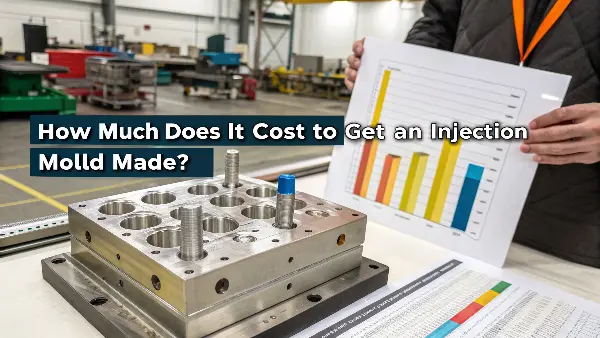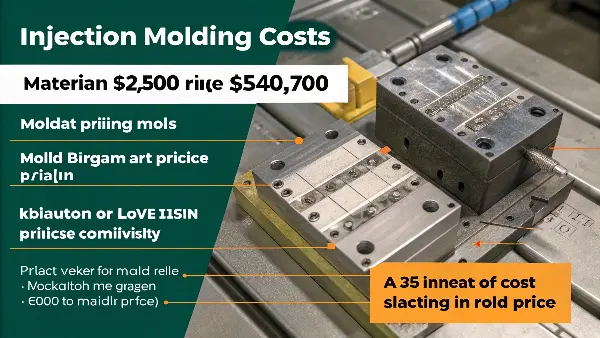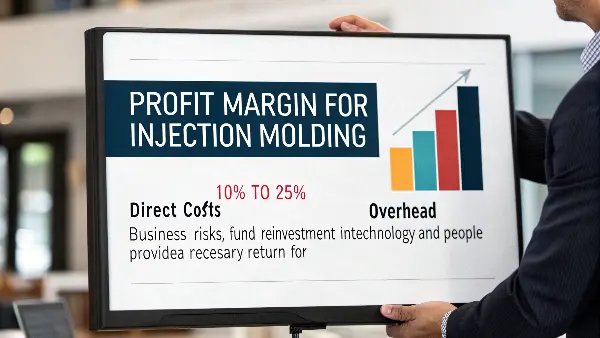Struggling to understand the wide range of quotes for injection molds? The complex factors and potential hidden costs can make budgeting a real challenge for your project. Understanding the breakdown is key.
Injection mold cost1 is a sum of factors: mold base and steel cost, design and engineering time, CNC machining hours2, specialized processes like EDM, component costs (sliders, lifters), assembly labor, polishing, and the mold maker’s overhead and profit3.
Getting a grip on mold pricing seems daunting, I know. I’ve worked with many designers like Jacky who need clarity to justify budgets and make informed decisions. It’s not just a single number; it’s a combination of many elements reflecting the tool’s complexity and required quality. Let’s dig into how these costs add up so you can approach your next quote with more confidence. Knowing the ‘how’ behind the price helps you partner effectively with your mold maker.
How Do You Calculate Injection Mold Cost?
Need a reliable way to estimate mold costs before getting quotes? Simply guessing based on past projects can lead to significant budget overruns, especially if complexity changes. Learn the core factors.
Calculate mold cost by adding: mold base cost, core/cavity steel cost, design hours, CNC machining time (roughing, finishing), EDM hours, component costs (ejectors, sliders, lifters, hot runners), assembly/fitting labor, polishing time, and overhead/profit.
!
Diving Deeper: The Calculation Elements
Breaking down the calculation helps demystify the final price. Each step involves specific resources and expertise, contributing to the total investment.
- Mold Design & Engineering: This isn’t just drawing the mold. It includes Design for Manufacturability (DFM) analysis, simulation (like mold flow), optimizing cooling channels, and planning for mechanisms like sliders or lifters. The hours spent here depend heavily on part complexity. More complex parts require more design time.
- Mold Base & Steel: The foundation is the mold base (standard sizes help control cost). The core and cavity steel choice depends on production volume, plastic type, and required finish.
-
Steel Types & Impact: Steel Type Typical Use Relative Cost Lifespan Expectancy Notes Aluminum Prototyping, Low Volume Low < 10,000 shots Fast machining, poor wear resistance P20 (Pre-hardened) Medium Volume Medium < 500,000 shots Good balance of cost and durability H13 (Hardened) High Volume, Abrasives High 1 Million+ shots Requires heat treat, excellent wear S136 (Stainless) High Volume, Corrosive High 1 Million+ shots For PVC, clear parts, high polish needs
-
- Machining: This is often the largest cost component.
- CNC Milling: Roughing out the basic shapes and precision finishing of cores, cavities, and components. Hours depend on size, complexity, and steel hardness.
- EDM (Electrical Discharge Machining): Used for features difficult to mill, like sharp internal corners, deep ribs, or textured surfaces. Sinker EDM and Wire EDM have different applications and costs.
- Components & Hardware: Standard parts like ejector pins, guide pins, bushings are relatively inexpensive. Complex actions (sliders, lifters, unscrewing mechanisms) add significant cost due to custom machining and fitting. Hot runner systems are a major cost adder compared to cold runners but reduce waste and cycle time.
- Labor (Assembly & Polishing): Skilled technicians assemble the mold, ensuring all components fit and function perfectly (spotting). Polishing the mold surface to the required finish (e.g., SPI standards A1-D3) is labor-intensive, especially for high-gloss finishes.
- Overhead & Profit: Covers the mold shop’s operating costs (rent, utilities, machine maintenance, support staff) and provides the necessary profit margin for the business.
Summing these detailed elements provides the basis for an accurate mold cost calculation.How Much Does it Cost to Get an Injection Mold Made?
Asking the big question: what’s the typical price tag for a mold? The huge variation you see in quotes can be confusing and make planning difficult. Understand the price ranges and what drives them.
Injection mold costs vary dramatically, from ~$2,000 for a very simple, single-cavity, aluminum prototype mold to $100,000+ for large, complex, multi-cavity, hardened steel molds with hot runners designed for millions of cycles.

Diving Deeper: Factors Influencing the Price Range
The final cost lands somewhere on that wide spectrum based on several key project specifics. As a designer like Jacky knows, small design details can have big cost implications.
- Part Size and Complexity: Larger parts require larger, more expensive mold bases and more steel. Complex features like undercuts (requiring sliders or lifters), intricate textures, tight tolerances, or internal/external threads significantly increase design, machining, and assembly time. A simple open-and-close mold is far cheaper than one with multiple actions. For example, adding just one side action (slider) can add thousands to the cost.
- Mold Material and Lifespan: As shown previously, the choice of steel directly impacts cost and the number of parts the mold can produce.
-
Material vs. Cost & Longevity: Mold Material Relative Cost Expected Lifespan (shots) Primary Application Aluminum 7075 Lowest < 10,000 Prototyping, very low volume P20 Steel Medium 50,000 – 500,000 Medium volume production H13 / S7 Hardened High 500,000 – 1,000,000+ High volume, abrasive materials S136 Stainless Highest 500,000 – 1,000,000+ Corrosive materials (PVC), optical parts
-
- Number of Cavities: A single-cavity mold produces one part per cycle. A multi-cavity mold (2, 4, 8, or more) produces multiple parts per cycle. Multi-cavity molds cost significantly more upfront (nearly proportional to cavity count for core/cavity work) but drastically reduce the cost per part during molding. The decision depends on total production volume requirements.
- Runner System: Cold runners are simpler and cheaper initially but waste plastic (the runner needs to be reground or discarded) and can increase cycle times. Hot runner systems eliminate runner waste and allow faster cycles but add substantially to the mold’s cost and complexity (requiring heaters, thermocouples, controllers).
- Required Surface Finish: A basic textured finish (like SPI D series) is cheapest. Progressively finer finishes (C series, B series) require more polishing time. Optical quality high-gloss finishes (SPI A series) demand hardened stainless steel and extensive, highly skilled hand polishing, adding significant cost.
- Mold Maker Location: Labor rates and operating costs vary globally. North American and European mold makers generally have higher costs than Asian suppliers. At CavityMold, we leverage global operations to offer competitive pricing while maintaining quality standards.
Understanding these drivers helps explain why seemingly similar parts can have vastly different mold costs.How Much Does Injection Molding Cost Per kg?
Thinking about material costs in terms of dollars per kilogram? It’s a common metric, but focusing solely on $/kg can be misleading when discussing mold pricing versus part pricing. Understand the distinction.
Injection mold cost isn’t quoted per kilogram of mold steel. While steel weight influences material cost, the primary drivers are machining complexity and labor. The plastic resin cost ($/kg) is crucial for the molded part price, not the mold price itself.

Diving Deeper: Mold Cost vs. Part Cost per kg
It’s vital to separate the cost of the tool (the mold) from the cost of the pieces it produces (the parts). The "$/kg" question usually relates more to the ongoing production cost.
- Mold Cost Recap: As we’ve detailed, mold cost is dominated by design, skilled labor for machining (CNC, EDM), assembly, polishing, and the complexity of components (sliders, lifters, hot runners). The weight of the steel used is a factor in the raw material cost line item, but it’s often overshadowed by the value added through manufacturing processes. A small, highly complex mold can cost much more than a large, simple one, even if the latter uses more steel (kg).
- Part Cost Calculation: The cost of each molded part is heavily influenced by the resin cost per kg. The formula is roughly:
Part Cost = (Resin Cost / Shot Weight) + (Machine Rate * Cycle Time / Parts per Cycle) + Labor + Packaging + Scrap.- Resin Cost ($/kg): Prices vary widely from commodity plastics (PP, PE ~$1-3/kg) to engineering grades (PC, ABS ~$3-6/kg) to high-performance materials (PEEK, PEI ~$50+/kg).
- Cycle Time: Faster cycles mean lower cost per part. Mold design (cooling, hot runners) impacts this.
- Machine Rate ($/hour): Cost of running the injection molding press.
-
How Plastic Choice Indirectly Affects Mold Cost: The specific plastic resin chosen for the part does influence the mold’s design and cost: Plastic Property Mold Requirement Impact on Mold Cost Example Plastic(s) Abrasive Fillers Hardened Steel (H13, S7) Higher steel cost, potentially slower machining Glass-Filled Nylon Corrosive Off-gassing Stainless Steel (S136) Significantly higher steel cost PVC High Shrinkage Rate Precise calculation & machining Increased design scrutiny, tighter tolerance machining PP, PE High Melt Temperature Robust Cooling Design May require more complex cooling channels PEEK, PEI Clarity/Optical Needs High Polish / Stainless Steel S136 steel, extensive polishing labor PC, Acrylic So, while you don’t price the mold per kg, the plastic choice (and its $/kg cost for parts) has important implications for the required mold material and complexity, thereby influencing the mold’s final price tag. Jacky needs to consider this interplay early when selecting materials.
What is the Profit Margin for Injection Molding?
Wondering about the business side – how much profit does a mold maker build into their quotes? Understanding typical margins helps you gauge if a quote is fair and competitive. It’s not just about covering costs.
Typical profit margins for custom injection mold making generally range from 10% to 25% over direct costs and overhead. This margin covers business risks, funds reinvestment in technology and people, and provides the necessary return for the company.

Diving Deeper: Understanding the Margin Components
The profit margin isn’t just extra money; it’s essential for a healthy, sustainable business that can reliably serve clients like Jacky long-term. Here’s what it typically encompasses:
- Covering Direct Costs: This is the base – the cost of steel, components, direct labor hours for design, machining, assembly, and polishing.
- Allocating Overhead: These are the indirect costs of running the shop: rent/mortgage on the facility, electricity, machine maintenance and depreciation, cutting tool consumables, CAD/CAM software licenses, administrative staff salaries, sales and marketing, insurance, etc. These costs must be factored into the price of every mold built.
- Managing Risk: Mold building involves inherent risks. Quotes might underestimate complexity, leading to cost overruns. Materials could have hidden flaws. Parts might not meet tolerance after molding, requiring mold adjustments (rework) often done at the mold maker’s expense, especially under warranty. The margin provides a buffer for these unknowns. I remember one project where unexpected steel warping during heat treatment required significant rework – the margin helped absorb that hit.
- Funding Reinvestment: To stay competitive and efficient, mold makers must invest in new technology (faster CNC machines, better software, advanced inspection equipment) and training for their staff. The profit margin is the primary source for these crucial investments that ultimately benefit the customer through better quality and potentially lower costs over time.
- Providing Business Return: Like any business, a mold shop needs to generate a return for its owners or shareholders to compensate them for their investment and the financial risks they undertake.
Factors Influencing the Margin Percentage:- Competition: Highly competitive markets may drive margins lower.
- Complexity & Specialization: Highly complex molds or those requiring niche expertise (e.g., optical molds, unscrewing molds) often command higher margins due to the increased risk and specialized skills involved.
- Urgency: Rush jobs may carry a premium.
- Client Relationship: Long-term, trusted partnerships might sometimes see slightly more favorable margins.
- Value Added: Shops providing significant upfront engineering support (DFM, simulation) factor that value into their pricing structure.
While mold makers won’t usually disclose their exact profit margin on a specific quote, understanding that it covers much more than just profit helps appreciate the overall pricing structure. Reputable suppliers like CavityMold focus on providing clear value and building trust through transparent communication about the cost drivers.Conclusion
Injection mold pricing is complex, influenced by design, size, materials, labor, complexity, and required lifespan. Understanding these cost drivers empowers you to evaluate quotes effectively and achieve fair value for your investment.
-
Understanding the factors that influence injection mold costs can help you budget more effectively and avoid hidden expenses. ↩
-
Exploring the impact of CNC machining hours on mold pricing can provide insights into cost management and efficiency. ↩
-
Learning about a mold maker’s overhead and profit can clarify pricing structures and help you negotiate better. ↩
